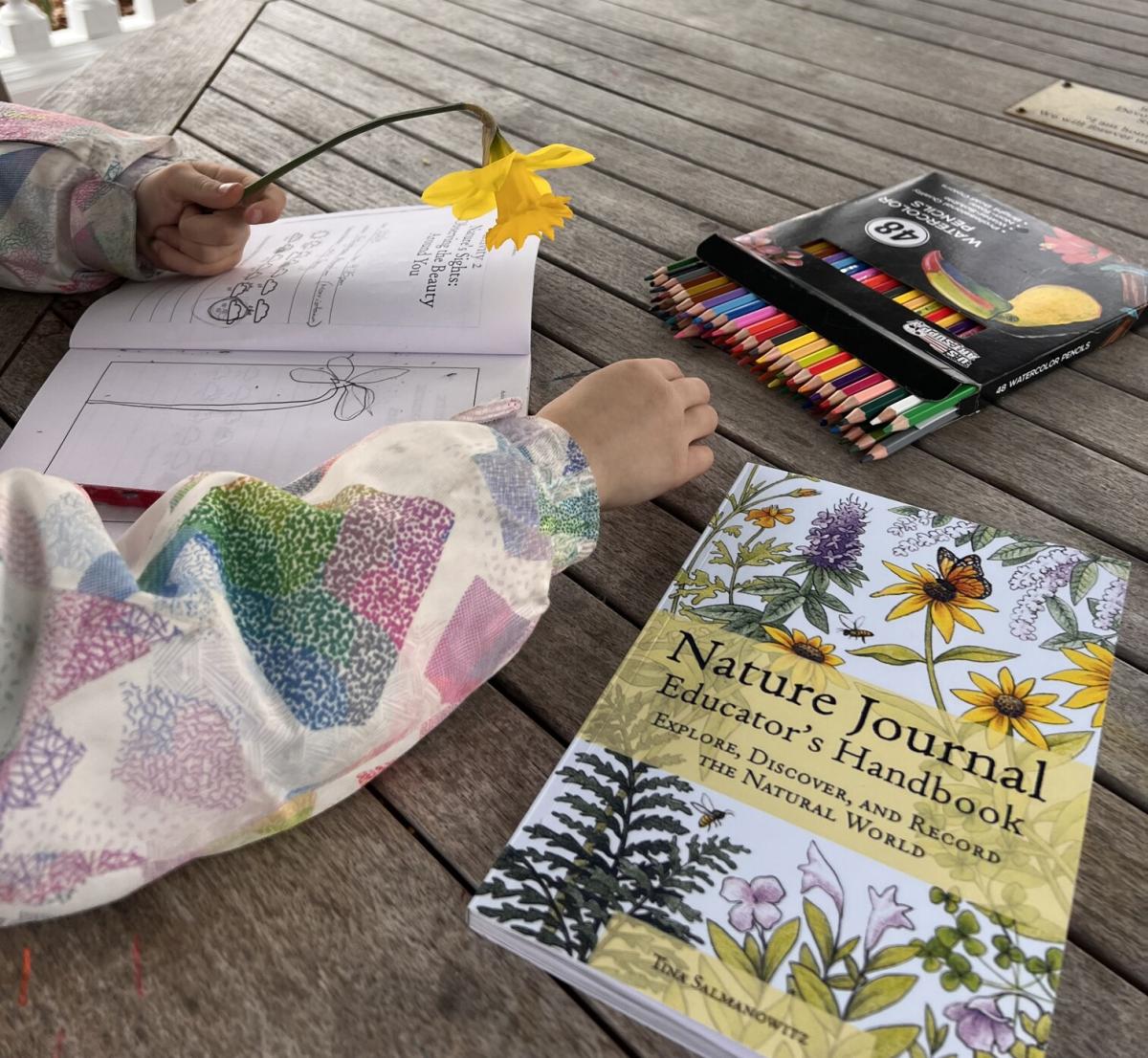Encouraging curiosity, creativity, and independent thinking
I love having low-prep, screen-free activities for kids that encourage independent play and exploration. Activities that promote important life skills such as creativity, critical thinking, observation, and resilience. And if it gets my kids outdoors or moving their bodies, that’s a bonus! Here are some of my favorites…
1️⃣ Nature Journaling
My girls and I started something we call Fresh Air Fridays. Each week, usually on Friday, we head outside to explore and journal. I keep a small backpack ready with everything we need: the girls’ nature journals, my Educator’s Handbook, pencils and colored pencils, erasers, binoculars, a magnifying glass, and of course, snacks.
The journal helps guide us in our weekly observations. After spending some time exploring, we find a cozy spot to sit, draw, and write about what we saw and experienced. We explore everything from unique plants, to shapes in the clouds, to different animal behaviors; anything that catches our eye.
This practice builds observation skills, encourages curiosity, and lays the foundation for scientific thinking. I especially love that it’s a relaxing activity that helps, not only my children, but also myself to slow down from our fast-paced lives and look closely at the world around us.
If you’re looking to start something similar with your kids, I’d be happy to help you get going. Little Monsters Universe’s nature journals offer simple prompts and plenty of space for kids to wonder, explore, and record what they notice. Or if you just want tips for getting started, check out the blog: How to Start a Nature Journaling Routine for Kids: Easy Tips for Busy Parents.
2️⃣ Puzzle Challenges
When the pieces don’t fit, the real fun begins! Puzzling is a favorite activity in our house, especially when grandma visits. We have a variety of puzzles for my girls to choose from. In addition to the classic jigsaw puzzle, we also have brain-teasers, tangrams, crosswords, Sudoku, and more.
I like to have different age-appropriate options available, as it keeps things fresh, and helps to build a diversity of skills. For example, some promote logical reasoning, while others strengthen pattern recognition. Overall, puzzles help build focus, perseverance, and problem-solving skills.
We store most of them in an accessible cabinet where my children can take them out to do on their own as a quiet-time activity. Other times, we choose one as a family and work on it together or even turn it into a fun challenge.
3️⃣ Recycled Materials Maker Station
While we don’t call ours a “Maker Station,” our craft room is where the magic happens and where my kids create their art and inventions. For us, this space is set up with various crafting materials (crayons, paints, glue, scissors, paper, clay, etc.) next to their craft table. The room also has a closet where they can access additional materials (mostly recycled items) like toilet paper tubes, bottle caps, string or ribbon, cardboard, and more.
All materials are labeled and within reach so the kids can freely experiment and create whenever inspiration strikes. They don’t need to wait for me; everything is set up so they can dive into creating independently, at their own pace, and in their own time. This simple setup gives them freedom and encourages creativity, confidence, and self-direction.
Choose materials based on your child’s age and readiness. For example, I keep all the paints on an upper shelf and out of reach, as my youngest isn’t quite ready to use them independently. If mess is something you struggle with, start with just a few simple materials and keep the messier ones tucked away until your child is ready. Having a collection of recycled or found objects also teaches resourcefulness and sparks creativity rooted in sustainability.
If I notice the craft room isn’t being used, I’ll challenge them to build something, such as a leprechaun trap, a bird feeder, or their own Rube Goldberg machine. There’s no wrong answer, and it helps develop design thinking and engineering skills through play.
4️⃣ Nature Walk with a Mission
My children aren’t fans of “just going for a walk,” but if I give them something to look for, then suddenly they’re excited. A simple question or challenge turns our stroll into a fun exploration. When they feel like they’re on a mini field expedition, they get excited, and it makes the walk more engaging. Do your kids need a little extra spark to enjoy nature walks too?
For example, my husband and I took the girls snowshoeing in Vermont this winter. We thought that would be an adventure in itself, but their interest faded quickly. To keep them engaged, I had them help me look for animal tracks in the snow and search for fruticose lichen (also known as bearded lichen), which we don’t see often at home. It felt like a real treat to find.
Giving kids a question to investigate or a goal to pursue transforms outdoor time into an inquiry-based adventure. It gets them thinking like scientists as they make observations, ask questions, and compare what they find. Below are some sample questions and goals you can explore.
Questions to Investigate:
- What kinds of animal tracks can you find?
- Can you find something soft, something rough, and something smooth?
- What colors do you see the most in nature today?
- How many different bird calls can you hear?
- How does the ground feel different in the sun vs. the shade?
Goals to Pursue:
- Collect five different-shaped leaves.
- Spot three insects in different habitats (like on a tree, in the grass, and on a rock).
- Find something that smells interesting.
- Look for something that’s changing (like budding leaves or melting snow).
- Find and compare two kinds of bark.
If you’re looking for more ways to make the most of your time outside, I’ve gathered some of our favorite ideas in this blog post: Exploring Nature’s Classroom: Outdoor Science Activities. It’s full of simple, engaging ways to turn everyday walks into hands-on learning experiences.
5️⃣ Build a Fort (Indoors or Out)
A few blankets, sticks, cushions, or even cardboard boxes, and suddenly, kids are building engineering skills without even realizing it. Fort-building is one of my kids’ favorite activities. They do it both indoors and outdoors, creating forts large enough for themselves as well as smaller ones for their dolls, stuffed animals, or mini action figures.
This activity encourages spatial reasoning, teamwork (if done with others), and imaginative thinking. Plus, forts become a quiet space for reading or pretend play afterward.
Final Thoughts: Let curiosity lead the way
These simple, screen-free activities have become staples in our home—not because they’re fancy or perfect, but because they invite curiosity, creativity, and connection. Whether we’re outside nature journaling, building with recycled materials, or curled up in a blanket fort, I love that my kids are learning, exploring, and growing through play. And the best part? Most of these ideas require little more than a few supplies and a willingness to slow down and say “yes” to their ideas.





